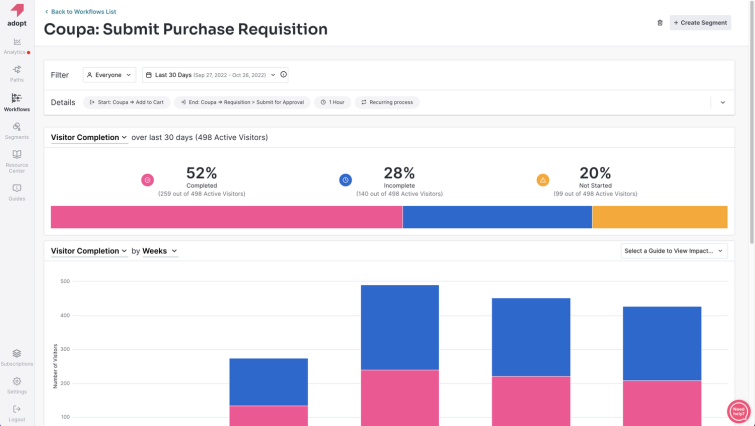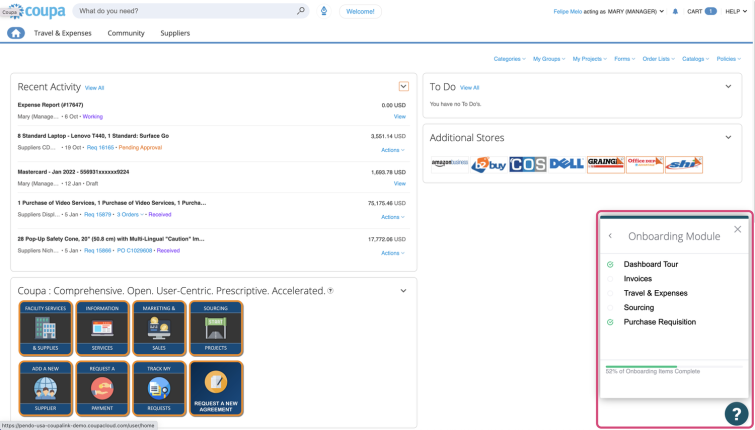How To Use the Scientific Method for Better Tech Adoption: Pendo and Coupa

Today's post is written by guest author Jonathan Ortiz — Account Executive at Pendo. Jonathan is a sales strategist, spending the last 15 years working in digital transformation, organizational effectiveness, and product management. Pendo is a certified Coupa App Marketplace partner that helps organizations increase employee adoption of Coupa.
If there’s one thing almost every company has in common, it’s the challenge of getting employees to embrace new technology. There are a few main reasons for that, according to Harvard Business Review. They include lack of employee skills, poor organizational culture, issues of complexity, and inadequate infrastructure. So, you’ve got a new Business Spend Management (BSM) platform. How will you actually get your employees to use it?
Adding the Pendo app can help address some of those challenges, particularly employee skills and complexity issues. Pendo provides in-app guidance modules to help users get up and running right away on Coupa’s platform, and uses a “scientific method” adoption approach to track, analyze, and provide insights on how to improve employee usage over time.
3 Stages of onboarding success
Software success is defined by how it's actually used — not what it can potentially do. In practice, this means that even the most powerful, best-in-class software may not live up to expectations if there's a disconnect between business deployment and employee adoption. This means software onboarding isn't a one-and-done event. Instead, Pendo believes there are three distinct stages of onboarding success.
Introduction
The first onboarding phase introduces staff to new software and gets buy-in. This is often accomplished prior to completing software rollouts. By giving staff a chance to see how a new BSM platform works, what features it offers, and how it integrates with existing processes, it's possible to reduce onboarding friction over time. It’s also important to show the value of the new software. How will it make an employee’s workday easier?
Adoption
Adoption comes next. In this stage, widespread software rollouts happen, and staff are encouraged to use new solutions in day-to-day operations. Data collection is critical at this stage. By capturing data about the time employees spend using the new BSM platform, the functions they carry out, and what other apps they use, it's possible to create a more holistic picture of adoption.
Improvement
Data sets the stage for improvement. For example, collected data may show that a specific subset of staff isn't using the new BSM platform as often as other employees. Equipped with this information, C-suites can assess what's causing the disconnect and create plans to improve adoption.
Manage adoption scientifically
One of the most common challenges in any adoption scenario is addressing only symptoms (the what) rather than root causes (the why). Consider a lack of software uptake six months after a new deployment. Analysis of user data and feedback shows limited logins to the new application, along with consistent complaints from staff that the software doesn't offer specific features. When faced with this situation, companies may double down on their investment by providing more — more training, more functions, and more features — without truly understanding why adoption is poor.
Pendo helps companies apply the scientific method to software adoption by hypothesizing, testing, and analyzing, which leads to continuous improvement. Pendo does this by examining an organization's usage data in multiple ways to determine which employees need help and how this help can best be delivered. Once a hypothesis is formed, companies deploy custom-built processes (onboarding, confirmations, etc.) and analyze their impact. If the impact is a net positive, then the hypothesis is confirmed, and companies can start again with a new assessment of adoption data for further refinement. If the impact is neutral or a net negative, businesses can disregard their initial hypothesis and then use collected data to create and test a new hypothesis.

By applying the rigors of a scientific approach, it's possible to quantify onboarding success, in turn making it possible to steadily improve user efficiency over time.
Pendo also guides employee training right inside Coupa through a simple browser extension — helping to drive adoption, gather insights, and improve time to value.

People over products
People, not products, drive productivity. Essentially, it's not the software that's doing the work — it's the employees using the software that makes productivity possible.
As a result, companies must create training and onboarding programs tailored to the individual. Consider a new Coupa deployment. Not all staff will have the same level of experience or technical insights about procure-to-pay, which means different employees will require different levels of assistance. While it's possible to create a broad onboarding program that focuses on common functions, this creates two end-of-spectrum issues — users with little to no procurement experience will still struggle with effective adoption. In contrast, those at the opposite end will find little to no value in the educational materials provided.
However, by using Pendo, it's possible for companies to track adoption of Coupa and use data at the individual employee level, in turn enabling team leaders to create tailor-made onboarding processes for each staff member.
Combined with research centers that populate content and connect it to a knowledge management system, staff have a combination of direct and self-service assistance to make the most of Coupa.
Download Pendo on the Coupa App Marketplace
